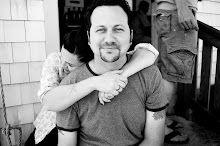
During my years working in New Orleans' Central Business District, I have endeavored to observe the culinary clock of our city by consuming red beans for lunch on Monday and seafood gumbo on Friday, served at local lunch counters and po-boy shops. As every New Orleanian knows, red beans are the standard Monday lunch offering throughout the city, because, traditionally, Monday was a "wash day" and your beans could sit cooking for hours without much attention while you cleaned up. (Seafood gumbo on Friday is connected to the city's Catholic traditions, which historically forbid meat on Fridays. I am pleased to live in a city where eating a fried shrimp po-boy or a bowl of gumbo counts as religious observance.)
Sometimes on Mondays, but more often on Saturday or Sunday when I have more time on my hands, I'll make red beans for dinner. Cooking red beans requires some forethought - the beans need to be soaked over night - and is somewhat labor intensive with lots of vegetable chopping. Red beans is (are?) the only dish that gets me cooking first thing in the morning, even before breakfast, because the longer the beans simmer with the pickled pork, sausage, trinity, and seasoning, the better it tastes at dinner time.
Untethered from any real calendar aside from the one that measures the days of my baby's life during my paternity leave, I made red beans last Thursday (pictured above) and have been eating them consistently since. (Has anyone else tried eating fried eggs on red beans? It's terrific. A New Orleans version of huevos rancheros. In the New Orleans greasy spoon restaurant that I conjure in my mind when I happen upon some terrific, geographically specific dish that I have never seen in a restaurant, it would be a best seller. Along with my Leidenheimer po-boy bread pain perdu.)
I work from a recipe that I found a few years ago, from a New Orleans ex-patriate on the internet. (Chuck Taggart at Gumbo Pages.) I always use dried Camellia Beans because I love the packaging and because no other bean could possibly get so creamy. (I have never tried any other brand but became convinced on the creaminess point after reading an article by New Orleans' finest journalist, Katy Reckdahl, about New Orleanians stuck in Phoenix, Arizona after Katrina and their passion for Camellias: "Sabrina Williams cringes as she opens her cupboard and pulls out her last pack of Camellia kidney beans, the only brand that cooks down into creamy and smooth New Orleans-style red beans — impossible to find in her adopted hometown, Glendale, Arizona. But Williams' timing is good. Her parents are currently in New Orleans, mucking out their house, and they will soon return to Phoenix, suitcases heavy with Camellia beans.")

Here are the ingredients I use:
2 pounds red kidney beans, dry
2 large onions, chopped
2 green peppers, chopped
5 ribs celery, chopped
1 1/2 pounds of pickled pork, without bones, diced, for seasoning
2 pounds hot smoked sausage, sliced and halved
1 tsp. dried thyme leaves, crushed
2 bay leaves
Red pepper and black pepper to taste
Salt to taste
Fresh sausage links, one link per person
The directions from Gumbo Pages:
Soak the beans overnight, if possible. The next day, drain and put fresh water in the pot. (This helps reduce the, um, flatulence factor.) Bring the beans to a rolling boil. Make sure the beans are always covered by water, or they will discolor and get hard. Boil the beans for about 45 - 60 minutes, until the beans are tender but not falling apart. Drain.While the beans are boiling, sauté the Trinity (onions, celery, bell pepper) until the onions turn translucent. Add the garlic and saute for 2 more minutes, stirring occasionally. [I omit garlic.] After the beans are boiled and drained, add the sautéed vegetables to the beans, then add the ham hock (or ham or pickle meat), smoked sausage, seasonings, and just enough water to cover.
Bring to a boil, then reduce heat to a low simmer. Cook for 2 hours at least, preferably 3, until the whole thing gets nice and creamy. Adjust seasonings as you go along. Stir occasionally, making sure that it doesn't burn and/or stick to the bottom of the pot. (If the beans are old -- say, older than six months to a year -- they won't get creamy. Make sure the beans are reasonably fresh. If it's still not getting creamy, take 1 or 2 cups of beans out and mash them, then return them to the pot and stir.)
If you can ... let the beans cool, stick them in the fridge, and reheat and serve for dinner the next day. They'll taste a LOT better. When you do this, you'll need to add a little water to get them to the right consistency.
Serve generous ladles-ful over hot white long-grain rice, with good French bread and good beer. I also love to serve grilled or broiled fresh Creole hot sausage or chaurice on the side. Do not serve with a canned-beet salad, like my Mom always used to do. (Sorry, Mom ... try something interesting with fresh beets and we'll talk. :^)
If you are not trying to feed an army, or don't want a week worth of left overs, you don't have to make two pounds of beans. Make a pound. Feed a smaller army.








